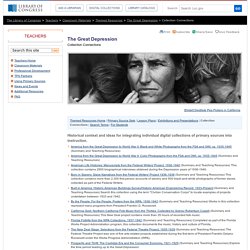

Dust Bowl During the Great Depression - American Memory Timeline- Classroom Presentation. 100 Years after WWI: The Lasting Impacts of the Great War. In this photo, circa 1918, the Students’ Army Training Corps marches in formation by the Hall of Languages.

This is one in a collection of photos from Syracuse University Archives that show WWI activity on campus. It was called the Great War and the war to end all wars. One hundred years later, the chaos and consequences of World War I, which began on July 28, 1914, when Austria-Hungary declared war on Serbia, had repercussions that continue to resonate in today’s world. The Dust Bowl - Primary Source Set. Skip navigation Library of Congress Teachers Suggestions enabled.

The Library of Congress > Teachers > Classroom Materials > Primary Source Sets > The Dust Bowl Print Subscribe Share/Save Give Feedback. The New Deal - Primary Source Set. The Neglect of Mental Illness Exacts a Huge Toll, Human and Economic. Mental health care is one of the biggest unmet needs of our time.

Nearly one in two people in the U.S. will suffer from depression, anxiety disorders or another mental health ailment at some point in their life, and about one in 17 Americans currently has a serious mental illness. Young people are especially prone to these troubles. Yet millions of people living with these conditions do not receive the care they require. In recent years the health system and state and federal governments have taken steps to right that wrong. Progress has been slow, and budget cuts and legal wrangling have now put many of these measures at risk. Mental illness strikes without regard for economic class, but the strain is acute for people with low incomes. Depression Era: 1930s: Repatriation for Mexican & Filipino Farm Workers. Mexican and Mexican American migrant farm workers expected conditions like those pictured above as they sought farm work in California and other states in the early 1900s.

At that time, the Mexican Revolution and the series of Mexican civil wars that followed pushed many Mexicans to flee to the United States. Many U.S. farm owners recruited Mexicans and Mexican Americans because they believed that these desperate workers would tolerate living conditions that workers of other races would not. Mexican and Mexican American workers often earned more in the United States than they could in Mexico's civil war economy, although California farmers paid Mexican and Mexican American workers significantly less than white American workers. The Great Depression - Facts & Summary. Hoover, a Republican who had formerly served as U.S. secretary of commerce, believed that government should not directly intervene in the economy, and that it did not have the responsibility to create jobs or provide economic relief for its citizens.

In 1932, however, with the country mired in the depths of the Great Depression and some 15 million people (more than 20 percent of the U.S. population at the time) unemployed, Democrat Franklin D. Roosevelt won an overwhelming victory in the presidential election. By Inauguration Day (March 4, 1933), every U.S. state had ordered all remaining banks to close at the end of the fourth wave of banking panics, and the U.S. Treasury didn’t have enough cash to pay all government workers. Nonetheless, FDR (as he was known) projected a calm energy and optimism, famously declaring that “the only thing we have to fear is fear itself.”
Collection Connections - The Great Depression - Themed Resources. Teachers Historical context and ideas for integrating individual digital collections of primary sources into instruction.

America from the Great Depression to World War II: Black and White Photographs from the FSA and OWI, ca. 1935-1945 (Summary and Teaching Resources) America from the Great Depression to World War II: Color Photographs from the FSA and OWI, ca. 1935-1945 (Summary and Teaching Resources) American Life Histories: Manuscripts from the Federal Writers' Project, 1936-1940 (Summary and Teaching Resources) This collection contains 2900 biographical interviews obtained during the Depression years of 1936-1940.
Top. National Steinbeck Center. Early Years: Salinas to Stanford: 1902-1925 John Steinbeck was born on February 27, 1902 in Salinas, California, the third child of Olive Hamilton, former school teacher, and John Ernst Steinbeck, manager at Sperry Flour mill.

He had two older sisters, Esther and Beth, and a younger sister, Mary. WGBH American Experience . Surviving the Dust Bowl . The Drought. Farms turned into dusty deserts.

The drought hit first in the eastern part of the country in 1930. In 1931, it moved toward the west. By 1934 it had turned the Great Plains into a desert. “If you would like to have your heart broken, just come out here,” wrote Ernie Pyle, a roving reporter in Kansas, just north of the Oklahoma border, in June of 1936. SPENT.